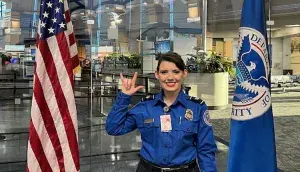 Huntsville International Airport TSA Officer Kayla Lowery-Busick uses sign language to communicate with passenger John Frick from northern Virginia. (Photo by Autumn Lovill)
Huntsville International Airport TSA Officer Kayla Lowery-Busick uses sign language to communicate with passenger John Frick from northern Virginia. (Photo by Autumn Lovill)
TSA Officer Kayla Lowery-Busick just celebrated her two-year anniversary with the agency, and she’s making a big impact at Alabama’s Huntsville International Airport (HSV), especially when it comes to welcoming deaf passengers at the checkpoint.
American Sign Language (ASL) is Lowery-Busick’s first language. Her parents were both born deaf, so ASL is the language she spoke at home growing up.
Now, she’s putting her ASL fluency to great use at HSV.
“When I started working for TSA, I truly did not realize how much I was going to use ASL on the checkpoint,” said Lowery-Busick. “I speak with deaf passengers at least twice a month. That interaction is as important as the more than 7,000 other passengers we screen weekly.”
TSA Explosives Training Officer Justin Jewett was amazed how Lowery-Busick engaged with a group of deaf students flying out of Huntsville after attending Space Camp. The dozens of students had an interpreter with them; however, Lowery-Busick was there to communicate, help them through the screening process and make their trip through HSV a memorable one.
“Communication barriers tend to be an obstacle during screening operations, but Kayla’s engagement with the group was impressive,” Jewett described. “She quite literally contributed to a positive experience and more effective screening. Kayla has embraced her family experience and applied it to her current position, and I believe TSA is better for it.”
Alabama TSA Federal Security Director Tara Corse said through programs like Space Camp, HSV officers see young people, ages 9 to 18, from all 50 states, U.S. territories and more than 150 foreign countries, many of whom are deaf, hard of hearing, blind, have limited vision or other disabilities.
“These groups provide our officers opportunities to interact with and assist with screening that is much different than our typical passengers,” said Corse. “I am proud of the diligence and care our officers show these young visitors. Kayla is a big part of ensuring we are successful with communicating at the checkpoint. Her skills are a blessing to HSV and TSA. She establishes a positive screening experience for the children and creates an environment of trust and compassion.”
When passengers who are deaf realize Lowery-Busick speaks ASL, they are ecstatic to know a TSA officer is available to explain the screening process and answer questions.
“Whenever a TSA officer discovers a passenger is deaf, they always give me a heads up so I can help that passenger, if necessary,” Lowery-Busick said. “More often than not, the screening process is smooth, but I still reach out to them to introduce myself and have a normal interaction with them just like I would with any other passenger. They are so grateful, and it makes me so happy that they feel included in their own experience.”
Lowery-Busick said people who are deaf are just as successful going through the checkpoint screening process as other travelers without much additional assistance.
“Deaf people are very aware of their surroundings, so they follow what the people around them are doing and really don’t have any major issues,” she noted. “Deaf passengers have mentally prepared themselves to navigate screening using whatever means available – passing notes, body language, etc. Like with any other language barriers, the interaction becomes less verbal and more physical with body language, gestures and facial expressions. When I speak with them in ASL, they are pleasantly surprised to have what to them is a normal conversation in a place where that doesn’t happen very often.”
Corse views Lowery-Busick’s ASL skills as an extension of the TSA Cares program through which TSA offers screening assistance to travelers who need it.
“We take for granted the ability to interact with others in our own language,” Corse emphasized, “but significant barriers to communicating in sign language deprive many deaf people of enjoying even these basic interactions. The screening process itself can be stressful, so to add additional challenges may make it even more difficult. Kayla’s skill provides individuals with on-time critical information to help alleviate any stress they may have and offers inclusive support.”
Lowery-Busick said the Deaf community is near and dear to her heart.
“They are my people, and I am always overjoyed to see someone using ASL,” she said. “I am even more excited when a deaf passenger has a positive interaction with TSA and has more confidence in their abilities to navigate the screening process.”
Because the general population doesn’t often interact with the Deaf community, Lowery-Busick said they expect deaf people to be fragile or need some “kind of special accommodation.”
Lowery-Busick offers the following tips for TSA officers:
“Deaf people are people; they just communicate differently. What officers need to know is that an interaction with a deaf person is just like an interaction with any other person. Help them understand the screening process, make them aware of what you’re going to do as far as pat-downs or property searches and do that in a respectful way.
“If you have someone who speaks ASL, by all means get them to help. But you can also use a pen and paper to write it down. Above all, be kind.”
By Don Wagner, TSA Strategic Communications & Public Affairs


